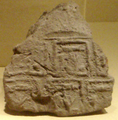- Narmer
-
Narmer 
Narmer, in the traditional pose of smiting the enemies of Egypt, cropped from the Narmer Palette c.3100 BC.Pharaoh of Egypt Successor Hor-Aha[1][2] -
Horus name: Narmer -


-
Consort(s) Neithhotep Mother Queen Shesh I[3] Burial Tomb B17/B18, Umm el-Qa'ab, Abydos Narmer was an ancient Egyptian pharaoh of the Early Dynastic Period (c. 32nd century BCE). He is thought to be the successor to the Protodynastic pharaohs Scorpion (or Selk) and/or Ka, and he is considered by some to be the unifier of Egypt and founder of the First Dynasty, and therefore the first pharaoh of unified Egypt.
The identity of Narmer is the subject of ongoing debate, although mainstream Egyptological consensus[1][2][4] identifies Narmer with the Protodynastic pharaoh Menes (or "Merinar" reversing the 2 hieroglyphs which spell "Narmer"). Menes is also credited with the unification of Egypt, as the first pharaoh. This conclusion of joint identity is evidenced by different royal titularies in the archaeological and historical records, respectively.
Contents
Reign
The famous Narmer Palette, discovered in 1898 in Hierakonpolis, shows Narmer displaying the insignia of both Upper and Lower Egypt, giving rise to the theory that he unified the two kingdoms in c. 3100 BC.[5]
The mainstream Egyptological consensus identifying Narmer with Menes is by no means universal. This has ramifications for the agreed history of ancient Egypt. Some Egyptologists hold that Menes is the same person as Hor-Aha and that he inherited an already-unified Egypt from Narmer;[6] others hold that Narmer began the process of unification but either did not succeed or succeeded only partially, leaving it to Menes to complete. Arguments have been made that Narmer is Menes because of his appearance on several ostraca in conjunction with the gameboard hieroglyph for "mn", which appears to be a contemporary record to the otherwise mythical king.[7]
At the site of Nahal Tillah (see below), a pottery shard was found with the serekh of king Narmer, showing that the Egyptian kings had five royal names, one of which also included the signs for "mn" (Menes), without further title but adjacent to the Horus name for Narmer. This would lead to the conclusion that Menes' royal names included "Narmer". However, there are inconsistencies within every ostracon which mentions Menes, precluding any definitive proof to his identity.[8] The king lists recently found in the tombs of Den and Qa'a both list Narmer as the founder of their dynasty, who was then followed by Hor-Aha (but Menes was absent).
Another equally plausible theory is that Narmer was an immediate successor to the king who did manage to unify Egypt (perhaps the King Scorpion whose name was found on a macehead also discovered in Hierakonpolis), but he adopted symbols of unification that had already been in use for perhaps a generation.[citation needed]
His wife is thought to have been Neithhotep (literally: "Neith is satisfied"), a princess of northern Egypt. Inscriptions bearing her name were found in tombs belonging to Narmer's immediate successors Hor-Aha and Djer, implying that she was the mother of Hor-Aha.
Tomb and artifacts
Narmer's tomb is composed of two joined chambers (B17 and B18) found in the Umm el-Qa'ab region of Abydos. It is located near the tomb of Ka, who ruled Thinis just before him.
During the summer of 1994, excavators from the Nahal Tillah expedition, in southern Israel, discovered an incised ceramic shard (ostracon) with the serekh sign of Narmer, the same individual whose ceremonial slate palette was found by James E. Quibell in Upper Egypt. The ostracon was found on a large circular platform, possibly the foundations of a storage silo on the Halif Terrace. Dated to c.3000 BC, mineralogical studies of the shard conclude that it is a fragment of a wine jar which had been imported from the Nile valley to Canaan.
Narmer had Egyptian pottery produced in southern Canaan — with his name stamped on vessels — and then exported back to Egypt.[9] Production sites included Tel Arad, Ein HaBesor, Rafah, and Tel Erani.[9]
Gallery of images
-
A mud jar sealing indicating that the contents came from the estate of the pharaoh Narmer. Originally from Tarkhan, now on display at the Metropolitan Museum of Art, New York City.
-
The Narmer Macehead, on display at the Ashmolean Museum, Oxford, UK.
-
Pottery shard inscribed with the serekh and name of the pharaoh Narmer, on display at the Museum of Fine Arts, Boston.
See also
- List of Pharaohs
- Narmer Palette
- Menes
- Thinis
References
- ^ a b Lloyd 1994: 7
- ^ a b Edwards 1971: 13
- ^ Wives and mothers
- ^ Cervelló-Autuori 2003: 174
- ^ Shaw, op.cit. p.196
- ^ Gardiner, op.cit. p.405
- ^ Gardiner, op.cit.
- ^ Gardiner, op.cit.
- ^ a b Naomi Porat, "Local Industry of Egyptian Pottery in Southern Palestine During the Early Bronze I Period", in Bulletin of the Egyptological, Seminar 8 (1986/1987), pp. 109-129.
Bibliography
- Cervelló-Autuori, Josep (2003). "Narmer, Menes and the seals from Abydos". Egyptology at the dawn of the twenty-first century: proceedings of the Eighth International Congress of Egyptologists, Cairo, 2000. 2. Cairo: The American University in Cairo Press. http://books.google.co.uk/books?id=pJ48YP14qZQC&printsec=frontcover&source=gbs_v2_summary_r&cad=0#v=onepage&q&f=false.
- Dodson, Aidan. Hilton, Dyan. The Complete Royal Families of Ancient Egypt, Thames & Hudson 2004
- Edwards, I. E. S. (1971). "The early dynastic period in Egypt". The Cambridge Ancient History. 1. Cambridge: Cambridge University Press.
- Gardiner, Alan. Egypt of the Pharaohs., Oxford University Press, 1961
- Kinnaer, Jacques. "What is Really Known About the Narmer Palette?", KMT: A Modern Journal of Ancient Egypt, Spring 2004.
- Lloyd, Alan B. ([1975] 1994). Herodotus: Book II. Leiden: E. J. Brill. ISBN 9004041796. http://books.google.co.uk/books?id=GQ7e1nuD9tcC.
- Shaw, Ian. The Oxford History of Ancient Egypt., Oxford University Press, 2000.
- Elwell, Douglas A. "Ah Osiria! Part IV: The Beast from the Sea". Mysterious World Journal: Winter 2003: http://www.mysteriousworld.com/Journal/2003/Winter/Osiria/
Categories:- Pharaohs of the First dynasty of Egypt
-
Wikimedia Foundation. 2010.




